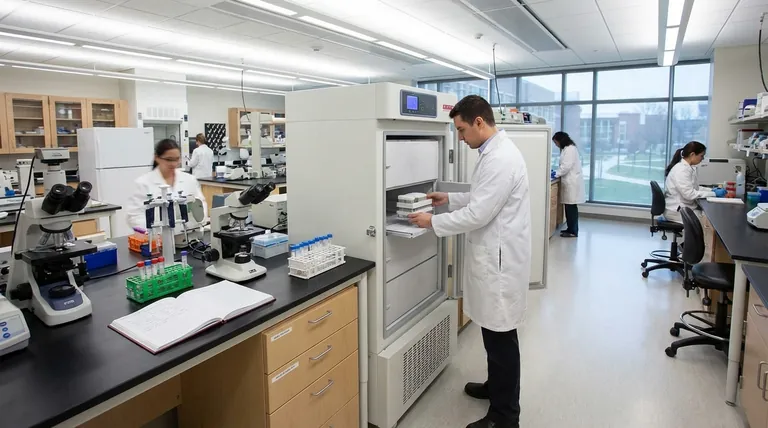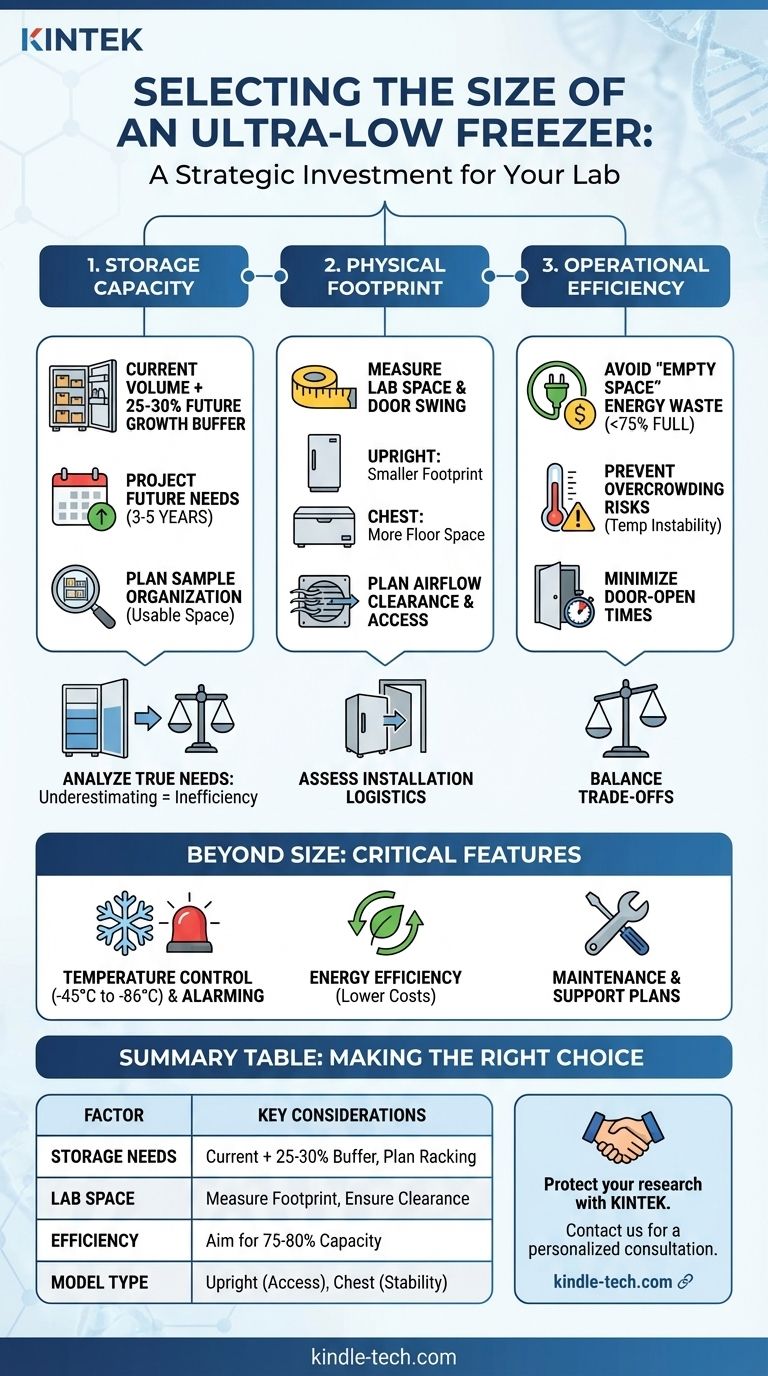The primary factors for selecting an ultra-low freezer size are your required storage capacity, the physical footprint available in your lab, and the operational efficiency of the unit. You must balance your current sample volume with projected future needs, ensuring the freezer you choose not only fits your space but also runs efficiently, as a mostly empty freezer wastes significant energy.
Choosing the right size for an ultra-low freezer is not just about accommodating your current samples. It's a strategic decision that balances future growth against the immediate costs of energy consumption and valuable lab space.

Analyzing Your True Storage Needs
The most common mistake is underestimating future needs or miscalculating the usable space. A thorough analysis is the critical first step.
Calculate Your Current Sample Volume
Start by conducting a complete inventory of all samples requiring ultra-low temperature storage. This includes everything from drugs and enzymes to chemicals and biological specimens.
Knowing your exact current volume provides the baseline for all other calculations.
Project Future Growth
A freezer is a long-term capital investment. Consider the direction of your research, potential new projects, and team growth over the next 3-5 years.
A good rule of thumb is to select a size that accommodates your current inventory plus a buffer of at least 25-30% for future expansion.
Consider Sample Organization
The stated capacity in cubic feet is not the same as usable space. Your choice of racks, boxes, and inventory systems will determine how efficiently you can use the internal volume.
Plan your racking configuration before finalizing a freezer size to ensure your organizational system fits and maximizes the available space.
Evaluating Your Physical Lab Space
An ideal freezer is useless if it cannot be installed and operated correctly in your facility.
Measure the Footprint
Ultra-low freezers are large and require a significant footprint. Upright models typically range from 13 to 30 cubic feet, while chest models can range from 2 to 27 cubic feet.
Measure the intended location carefully, accounting for both the unit's dimensions and the space required for door swing and user access.
Plan for Airflow and Access
These units generate considerable heat and require adequate clearance for ventilation, typically several inches on all sides. Obstructed airflow can lead to overheating, reduced efficiency, and premature component failure.
Ensure the location also provides unobstructed access for routine maintenance and potential emergency repairs.
Assess Installation Logistics
Before purchasing, map the delivery path from the loading dock to the final location. Measure all doorways, hallways, and elevators to ensure the unit can be moved into your lab without issue.
Understanding the Trade-offs
Choosing a size involves balancing competing priorities. A larger freezer offers more room for growth but comes with distinct disadvantages if not managed properly.
The Cost of Empty Space
A freezer that is consistently less than 75% full is highly inefficient. The system must work harder to cool the empty air, leading to higher energy consumption and increased wear on the compressor.
This wasted energy translates directly into higher operational costs over the life of the unit.
The Risk of Overcrowding
Conversely, a freezer that is too small and becomes overcrowded can compromise sample safety. Overfilling obstructs internal airflow, which can create warm spots and cause temperature instability.
It also makes inventory management difficult, increasing the time the door is open and further stressing the cooling system.
Upright vs. Chest Models
The physical orientation impacts both footprint and usability. Upright freezers offer a smaller footprint for their volume and easier sample organization and access.
Chest freezers often provide better long-term temperature stability and energy efficiency due to less cold air loss when opened, but they require more floor space and can be more challenging to organize.
Beyond Size: Essential Supporting Features
While size is a primary concern, several other features are critical for protecting your samples and ensuring reliable operation.
Temperature Control and Alarming
The freezer must maintain a precise temperature, typically between -45°C and -86°C. Look for models with robust temperature monitoring and alarm systems that alert you immediately to any deviations.
These safety features are your first line of defense against the catastrophic loss of valuable samples.
Energy Efficiency
Modern freezers offer significant improvements in energy efficiency through better insulation and advanced cooling technology. An energy-efficient model can dramatically reduce long-term operational costs.
Maintenance and Support
Consider the availability of customizable extended warranties and preventive maintenance plans. Proactive service ensures the freezer operates at peak performance and extends its lifespan, protecting your investment.
Making the Right Choice for Your Lab
Base your final decision on a clear understanding of your lab's primary goals.
- If your primary focus is accommodating rapid growth: Opt for a slightly larger model than you currently need, but commit to implementing an efficient racking system from the start to avoid energy waste.
- If your primary focus is maximizing limited space: A tall, narrow upright freezer is your best option, paired with a meticulous digital inventory system to minimize door-open times.
- If your primary focus is long-term energy efficiency: Choose a size that will be at least 75-80% full within a year and strongly consider a high-efficiency chest model if your lab's workflow and space allow.
Ultimately, selecting the right freezer is about making a strategic investment in the future of your research.
Summary Table:
| Factor | Key Considerations |
|---|---|
| Storage Needs | Current sample volume + 25-30% future growth buffer; plan racking for usable space. |
| Lab Space | Measure footprint and door swing; ensure adequate clearance for ventilation and access. |
| Efficiency | Aim for 75-80% capacity to avoid energy waste from empty space or risks from overcrowding. |
| Model Type | Upright: smaller footprint, easier access. Chest: better stability, more floor space. |
Protect your valuable research samples with the right ultra-low freezer from KINTEK.
Choosing the correct freezer size is critical for your lab's efficiency and sample integrity. KINTEK specializes in providing high-quality lab equipment, including ultra-low freezers, tailored to meet the specific storage and space requirements of research laboratories. Our experts can help you analyze your needs to select a model that balances capacity, energy efficiency, and footprint—ensuring your investment supports your work both now and in the future.
Contact us today to discuss your ultra-low storage requirements and find the perfect solution for your lab. Get in touch via our contact form for a personalized consultation.
Visual Guide

Related Products
- 158L Precision Vertical Ultra Low Freezer for Laboratory Applications
- 58L Precision Laboratory Ultra Low Temperature Upright Freezer for Critical Sample Storage
- 508L Advanced Vertical Ultra Low Temperature Freezer for Critical Laboratory Storage
- 938L Vertical Ultra Low Temperature Freezer for Advanced Laboratory Storage
- 108L Vertical Ultra Low Temperature ULT Freezer
People Also Ask
- In what fields are ultra low temperature freezers most commonly used? Essential for Biomedical, Clinical, and Research Labs
- How do Ultra-Low Temperature freezers ensure the integrity of microbiological samples? Maintain Stability for Critical Research
- What features do ultra-low temperature freezers typically include? Ensuring Absolute Sample Security
- What are the common applications of ultra-low temperature freezers? Preserve Your Most Valuable Samples
- What temperature range do Ultra-Low Temperature freezers maintain? The -80°C Standard for Sample Integrity



















